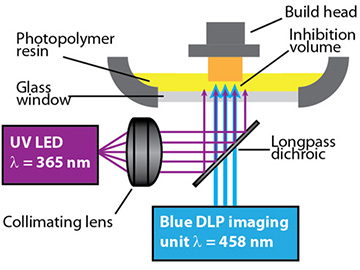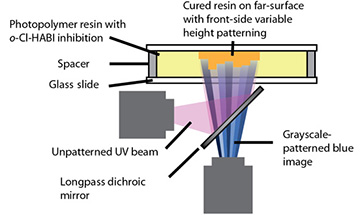![]()
A team at the University of Michigan has reportedly developed a two-wavelength additive-manufacturing system that can create 3-D printed objects at translations rates as much as ten to a hundred times faster than previous approaches. [Image: Evan Dougherty/University of Michigan]
Additive manufacturing (AM), more colloquially known as 3-D printing, is already revolutionizing a range of industrial and scientific efforts. But the conventional process of building up 3-D shapes in a series of 1-D line scans can be achingly slow. And even the recently developed approaches that use patterned light to cure entire 2-D cross sections in a single shot are often limited to print speeds on the order of centimeters to tens of centimeters per hour.
Now, researchers from the University of Michigan, USA, have reported a system that can build up 3-D-printed objects much faster, with rates on the order of two meters per hour—and that can even create complex, “bas relief” 3-D surfaces in a single shot (Sci. Adv., doi: 10.1126/sciadv.aau8723). The secrets: A little additional resin chemistry, and a dose of UV light added to the mix.
Building 2-D layers
The most familiar forms of 3-D printing build up plastic layers in a series of 1-D lines that are cured with laser light or other methods, a glacially slow process that puts a hard limit on production throughput. As an answer to that, the AM community has focused on so-called stereolithographic approaches.
In these schemes, patterned light approximating 2-D cross-sections of the 3-D object to be built—like the slices in a CAT scan—are shot from below through a window into a vat of photocurable resin. As each 2-D layer is cured, a build head slowly draws the object up out of the resin bath so that the next layer beneath can be cured. By allowing the construction of an entire 2-D layer in a single shot, the stereolithographic approach can dramatically shorten 3-D printing times relative to the many-hour timescales of 1-D approaches.
Sticky windows
But even stereolithographic AM has its hiccups. The most obvious one is that, as the patterned light from below cures each layer, the layer tends to stick to the very window through which the light is shining. That, in turn, necessitates a time-consuming separation step between each 2-D layer.
One approach to ameliorating this has been to make the projection window oxygen permeable. The permeable window creates an ultra-thin, oxygen-rich layer between the projection window and the growing 3-D item in which resin solidification is inhibited. Even these systems, however, are capped at vertical translation speeds of several tens of centimeters per hour, and the need for a thin, oxygen-permeable window makes them difficult to scale for efficiently producing large objects.
UV light control

The new method uses near-UV light to inhibit solidification in a controlled zone near the projection window, and blue light to solidify an entire 2-D layer in a single shot above the inhibition zone. A build head draws the 3-D object, built up of a succession of single-shot 2-D layers, out of the resin bath. [Image: M.P. deBeer et al., Sci. Adv., doi: 10.1126/sciadv.aau8723; CC BY-NC 4.0]
The Michigan team, led by Timothy Scott and Mark Burns, appear to have gotten around this problems, by using light, rather than oxygen, to inhibit resin curing near the projection window. The method begins in the chemistry lab, by adjusting the photocurable resin to include not only a photoactivator that cures and hardens the resin when hit by blue (458 nm) light, but also a photoinhibitor that prevents resin solidification in the presence of near-UV (365 nm) light.
To create a 3-D object, LED light at the latter wavelength is shot up through a glass projection window into a resin vat, creating the required solidification-free zone near the window. At the same time, patterned blue light from a commercial DLP projector is directed up through the window, and cures a 2-D layer of the desired 3-D object immediately above the zone where solidification is inhibited. As each 2-D layer is formed, the build head draws the steadily growing object up from the bath. Tweaking the relative intensities of the UV and blue light allows the thickness of the solidification-free zone to be adjusted.
Because the UV light inhibits solidification near the projection window, the system can build up the 3-D object continuously—and fast. Using the method, the team says, it has achieved print speeds on the order of two meters per hour, an order of magnitude faster than those of stereolithographic systems that rely on oxygen-permeable windows. And the ability to adjust the thickness of the solidification-free zone allows the process to potentially fit a variety of resin types and viscosities, making it potentially more scalable to building bigger, more robust pieces at production rates.
A Michigan YouTube video shows a 3-D model of the university logo, drawn up out of the resin bath.
Single shot, “bas relief” printing
Even more intriguing, the researchers point out that, for some applications, their two-color system has the ability to create complex 3-D topographies in a single exposure, rather than building up the 3-D surface layer by layer. In this scheme, a blue light of spatially varying intensity is superimposed on a uniform, collimated UV light source.

The researchers report that their two-color approach allows 3-D topographic surfaces to be fashioned in a single exposure, by spatially varying the intensity of light and, thus, the thickness of the zone in which resin solidification is inhibited. [Image: M.P. deBeer et al., Sci. Adv., doi: 10.1126/sciadv.aau8723; CC BY-NC 4.0]
Because the thickness of the no-solidification zone depends on the relative intensities of the blue and UV light, that means that the height of solidification can be different for different parts of the combined light field. That allows complex topographic surfaces to be created in a single exposure. That ability to create single-shot 3-D surfaces makes the system, according to co-lead investigator Burns, “one of the first true 3-D printers ever made.”
The university says it has filed three patent applications on the approach, and that Scott is preparing to launch a startup company to commercialize it.
